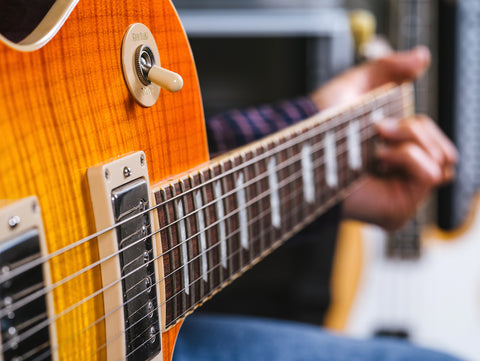-
Audio
-
Guitar
-
Bass
-
Blog
-
SALE
- Financing
- Support
- SINCE 1946
July 01, 2016

Knowing how to intonate your instrument is an essential part of setting it up to play optimally. Intonation is basically how well your guitar stays in tune with itself across the length of the fretboard. If all your strings are tuned correctly, but notes or chords played higher up on the fretboard sound off pitch, then you definitely need to adjust your intonation. Fret not- it’s a fairly simple process that this guide will walk you through step by step!
The Basics Behind Intonation
The process of setting intonation involves adjusting the length of the string by moving the bridge saddles forward or back. To move the saddle forward, you will loosen the screw. To move it back, you will tighten the screw.
What You’ll Need to Set Intonation
Aside from your guitar, the materials you will need to check intonation are: an instrument cable, an electronic tuner, and a small Phillips head screwdriver. Some guitar models will need a flat head screwdriver. Simply check the bridge saddle screws and you will know which type of screwdriver to use.
It also helps to work in a well-lit area and to have a large, stable surface to place your guitar on. Much of the intonation process requires both hands, so it’s best to not have your guitar sitting on your lap!
Intonating Your Guitar
Now it’s time to get down to business! Plug your guitar into the tuner. For each string you will want to do the following:
While setting intonation, take your time and don’t worry if it’s not perfect- it just has to be close enough! Fretted instruments by nature do not intonate perfectly. Also, if you are making any other changes to your guitar’s setup, like the string height or truss rod, it’s best to do it before setting the intonation. If you adjust the string height after setting intonation, the string length will change and you will have to set your intonation all over again! Setting intonation is a crucial part of the guitar set up process and will probably have to be done every time you change strings, especially if you switch to a different make of strings.
October 02, 2025
Discover the features and performance that the WG6 Wireless Guitar/Bass System has to offer. The WG6 Wireless Guitar/Bass System is designed to give you the wireless freedom you have been looking for and the simplicity to make your life as a working musician easier. Advanced wireless technology, multiple channel capability, premium audio processors make the WG6 the leader in compact wireless instrument systems. Defined and detailed low frequency response makes this system especially useful for bass players. The WG6 works with both active and passive instruments and is perfect for both electric and acoustic guitar/bass.
March 28, 2025
At any time at any gig, something is bound to go wrong and you may need a tool to get you back up and running. Here are a few basic tools you should bring to every gig.
January 09, 2025
I once asked blues legend Walter Trout why he still plays his well-worn vintage Strat. The technology exists to digitally scan the guitar and make very accurate replicas. His response was he could leave it at home, but then it will never be played. Plus, someone could steal it from his home. At least the guitar is with him and he has the pleasure of playing it. But this may not be the same for everyone.
Sign up to get the latest on sales, new releases and more…
NoFraud Frequently Asked Questions
"Make a joyful noise unto the Lord all of the earth; make a loud noise and rejoice and sing praises. Sing to the Lord with the harp and the voice of the psalm." - Psalm 98:4-5
© 2025 Carvin Audio.
Carvin Corp.
POS and Ecommerce by Shopify
